
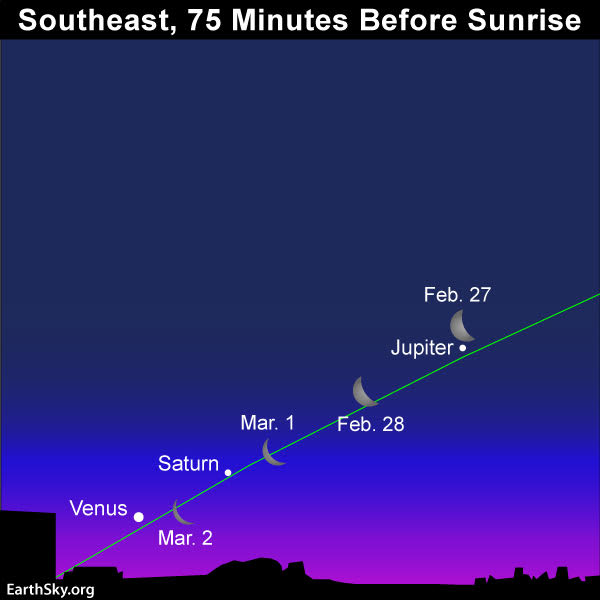
In late February and early March 2019, watch the moon go by Jupiter, Saturn and Venus. Read more.
Click the name of a planet to learn more about its visibility in March 2019: Venus, Jupiter, Saturn, Mars and Mercury
Post your planet photos at EarthSky Community Photos
Help EarthSky keep going! Please donate what you can to our once-yearly crowd-funding campaign.
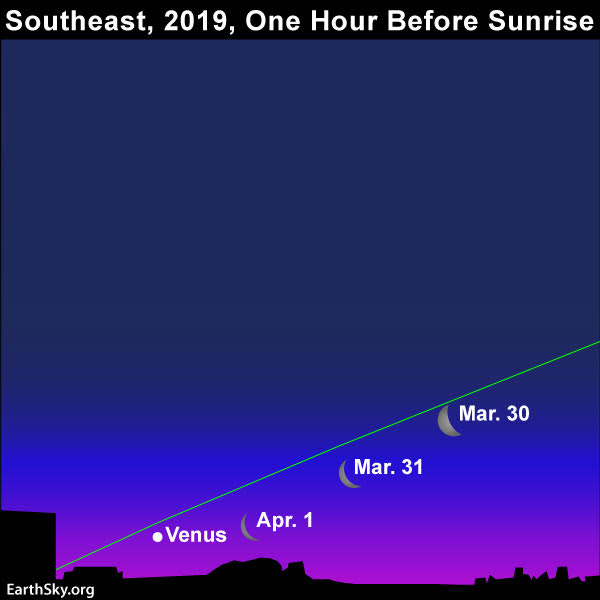
If you miss the moon near Venus in late February/early March, try again one month later, in late March/early April. Read more.
Venus is the brightest planet, beaming mightily in the east in the predawn/dawn sky all month long. Watch for the waning crescent moon to join up with Venus in the morning sky for a few days, centered on or near March 2 – and then again on April 1.
Venus reached a milestone in the morning sky on January 6, 2019, as this blazing world showcased its greatest elongation from the sun. In other words, on that date, Venus was a maximum angular distance of 46 degrees west from the sun on our sky’s dome. Ever since, Venus has been slowly but surely sinking sunward.
Day by day, Venus spends a little less time in the predawn sky before sunrise with each passing morning, but it’ll still be dazzlingly bright and visible at dawn for months to come. At mid-northern latitudes, Venus will rise before astronomical twilight (dawn’s first light) until mid-March 2019; and at temperate latitudes in the Southern Hemisphere, Venus will rise before astronomical twilight until the end of May 2019.
Click here to find out when astronomical twilight comes to your sky, remembering to check the astronomical twilight box.
At mid-northern latitudes, Venus rises about two hours before sunrise in early March. By the month’s end, that’ll taper to about 1 1/2 hours.
At temperate latitudes in the Southern Hemisphere, Venus rises about 3 hours before sunup in early March. By the month’s end that’ll taper to about 2 1/2 hours.
At the month’s end and in early April, let the waning crescent moon serve as your guide to the planet Venus. See the sky chart for the morning spectacular above.
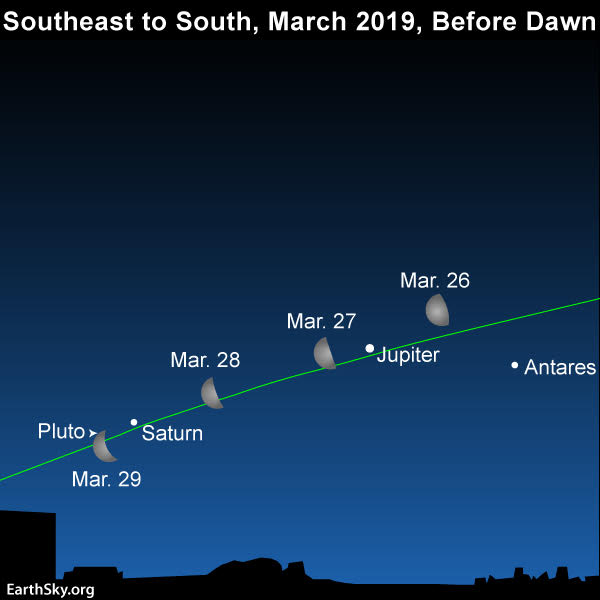
Let the moon be your guide to the king planet Jupiter on March 26 and 27. Read more.
Jupiter is the second-brightest planet after Venus. The king planet reigns at the top of the morning lineup of three bright planets. Jupiter sits at the peak, Saturn in between, and Venus at the bottom. This procession of morning planets finds Jupiter rising first, in the wee hours after midnight, followed by Saturn a few hours later, and then Venus before daybreak. (See the chart below for a larger panorama of sky.)
Click here for a recommended sky almanac telling you when Jupiter, Saturn and Venus rise into your sky.
If you’re up during the predawn hours, you might notice a bright ruddy star in the vicinity of Jupiter on the sky’s dome. That’s Antares, the brightest star in the constellation Scorpius the Scorpion. Although Jupiter shines in the vicinity of Antares all year long, Jupiter can be seen to wander relative to this “fixed” star of the zodiac. Jupiter travels eastward, away from Antares, until April 10, 2019. Then, for a period of four months (April 10 to August 11, 2019), Jupiter actually moves in retrograde (or westward), closing the gap between itself and the star Antares. Midway through this retrograde, Jupiter will reach opposition on June 10, 2019, to shine at its brilliant best for the year.
Watch for the waning crescent moon to swing by Jupiter on March 26 and 27.
From mid-northern latitudes, Jupiter rises about 2 hours after midnight. By the month’s end, Jupiter will rise around the midnight hour. Keep in mind that by midnight, we mean midway between sunset and sunrise.
From temperate latitudes in the Southern Hemisphere, Jupiter comes up around midnight at the beginning of the month. By the month’s end, Jupiter rises around two hours before the midnight hour.
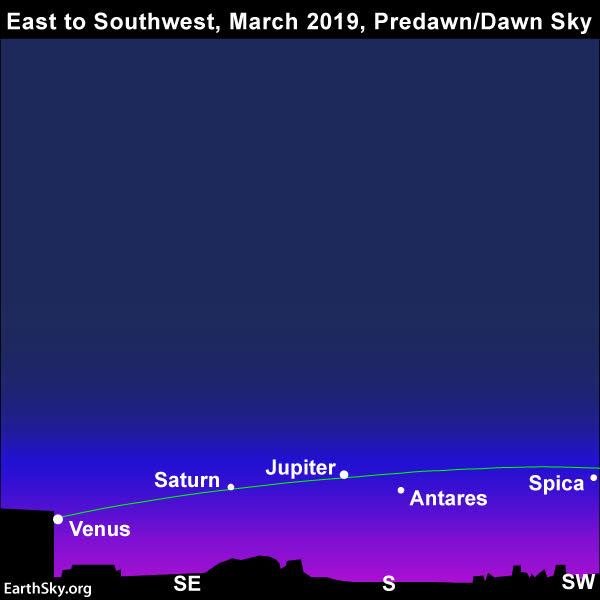
In the March predawn/dawn sky, look for Saturn in between Jupiter and Venus. This chart covers much more area than our typical charts do. The stretch from SE (southeast) to SW (southwest) circles one-fourth the way around the horizon.
Saturn swung over to the morning sky, at least nominally, on January 2, 2019. Saturn is now a fixture of the morning sky, coming up well before dawn’s first light. Throughout the month, you can view Saturn in between the king planet Jupiter and the queen planet Venus as the morning darkness ebbs toward dawn.
Day by day throughout March, Saturn and Jupiter climb upward, away from the sunrise. Venus, on the other hand, sinks sunward by the day. Saturn, although as bright as a 1st-magnitude star, pales in contrast to Venus and Jupiter. Venus and Jupiter rank as the third-brightest and fourth-brightest celestial objects, respectively, after the sun and moon.
From mid-northern latitudes, Saturn rises about 2 1/2 hours before the sun in early March. That’ll increase to about 3 1/2 hours before sunup by the month’s end.
From temperate latitudes in the Southern Hemisphere, Saturn rises about two hours after midnight in early March, and by the month’s end, comes up around the midnight hour. As a reminder, midnight in our usage means midway between sunset and sunrise.

Give it a try if you’d like, but spotting the moon and Mercury will be difficult on April 2, 2019 – especially at northerly latitudes. Read more.
Mercury, the innermost planet of the solar system, may be viewed in the evening sky in early March from northerly latitudes. After that, Mercury quickly descends into the glare of sunset and then transitions over into the morning sky at mid-month. Southerly latitudes will be able to spot Mercury in the morning sky by the month’s end.
Looking ahead, Mercury will adorn the morning sky all through April 2019. For the Southern Hemisphere, the month of April will present the best morning apparition of Mercury for the year. At northerly latitudes, Mercury’s morning appearance in April will be obscured by morning twilight.
At mid-northern latitudes, Mercury rises less than one hour before the sun in the waning days of March. In contrast, at temperate latitudes in the Southern Hemisphere, Mercury comes up better than 1 1/2 hours before the sun in late March.
At southerly latitudes, Mercury will rise before dawn’s first light all through April 2019.
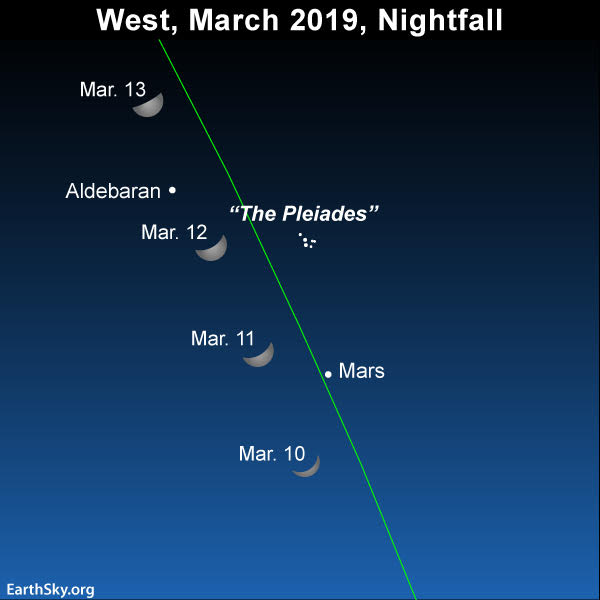
Watch for the moon to be in the vicinity of the red planet Mars on March 10 and 11. Read more.
Mars is the only bright planet to appear in the March evening sky all month long. Although Mars dims somewhat over the month, it remains modestly-bright, exhibiting 1st-magnitude brightness all month long (though just barely). Moreover, Mars stays out till late evening at mid-northern latitudes, and until early to mid-evening in the Southern Hemisphere.
Click here for recommended sky almanacs providing you with the setting times for Mars.
Watch for the moon to shine in the vicinity of Mars on the evenings of March 10 and 11.
Look for Mars to pair up with the Pleiades cluster in late March, as displayed on the sky chart below. You may – or may not – need binoculars to see the Pleiades. Watch Mars now because the red planet will fade into a 2nd-magnitude object by early April 2019.

In late March 2019, use the planet Mars to locate the Pleiades star cluster and the red giant star Aldebaran. Read more.
What do we mean by bright planet? By bright planet, we mean any solar system planet that is easily visible without an optical aid and that has been watched by our ancestors since time immemorial. In their outward order from the sun, the five bright planets are Mercury, Venus, Mars, Jupiter and Saturn. These planets actually do appear bright in our sky. They are typically as bright as – or brighter than – the brightest stars. Plus, these relatively nearby worlds tend to shine with a steadier light than the distant, twinkling stars. You can spot them, and come to know them as faithful friends, if you try.
Bottom line: In March, Mars shines in the evening sky all month long, whereas Venus, Jupiter and Saturn adorn the morning sky. Mercury appears in the evening sky in early March and then the morning sky in late March. Click here for recommended almanacs; they can help you know when the planets rise and set in your sky.
Don’t miss anything. Subscribe to EarthSky News by email
Help EarthSky keep going! Donate now.
from EarthSky https://ift.tt/1YD00CF


In late February and early March 2019, watch the moon go by Jupiter, Saturn and Venus. Read more.
Click the name of a planet to learn more about its visibility in March 2019: Venus, Jupiter, Saturn, Mars and Mercury
Post your planet photos at EarthSky Community Photos
Help EarthSky keep going! Please donate what you can to our once-yearly crowd-funding campaign.

If you miss the moon near Venus in late February/early March, try again one month later, in late March/early April. Read more.
Venus is the brightest planet, beaming mightily in the east in the predawn/dawn sky all month long. Watch for the waning crescent moon to join up with Venus in the morning sky for a few days, centered on or near March 2 – and then again on April 1.
Venus reached a milestone in the morning sky on January 6, 2019, as this blazing world showcased its greatest elongation from the sun. In other words, on that date, Venus was a maximum angular distance of 46 degrees west from the sun on our sky’s dome. Ever since, Venus has been slowly but surely sinking sunward.
Day by day, Venus spends a little less time in the predawn sky before sunrise with each passing morning, but it’ll still be dazzlingly bright and visible at dawn for months to come. At mid-northern latitudes, Venus will rise before astronomical twilight (dawn’s first light) until mid-March 2019; and at temperate latitudes in the Southern Hemisphere, Venus will rise before astronomical twilight until the end of May 2019.
Click here to find out when astronomical twilight comes to your sky, remembering to check the astronomical twilight box.
At mid-northern latitudes, Venus rises about two hours before sunrise in early March. By the month’s end, that’ll taper to about 1 1/2 hours.
At temperate latitudes in the Southern Hemisphere, Venus rises about 3 hours before sunup in early March. By the month’s end that’ll taper to about 2 1/2 hours.
At the month’s end and in early April, let the waning crescent moon serve as your guide to the planet Venus. See the sky chart for the morning spectacular above.

Let the moon be your guide to the king planet Jupiter on March 26 and 27. Read more.
Jupiter is the second-brightest planet after Venus. The king planet reigns at the top of the morning lineup of three bright planets. Jupiter sits at the peak, Saturn in between, and Venus at the bottom. This procession of morning planets finds Jupiter rising first, in the wee hours after midnight, followed by Saturn a few hours later, and then Venus before daybreak. (See the chart below for a larger panorama of sky.)
Click here for a recommended sky almanac telling you when Jupiter, Saturn and Venus rise into your sky.
If you’re up during the predawn hours, you might notice a bright ruddy star in the vicinity of Jupiter on the sky’s dome. That’s Antares, the brightest star in the constellation Scorpius the Scorpion. Although Jupiter shines in the vicinity of Antares all year long, Jupiter can be seen to wander relative to this “fixed” star of the zodiac. Jupiter travels eastward, away from Antares, until April 10, 2019. Then, for a period of four months (April 10 to August 11, 2019), Jupiter actually moves in retrograde (or westward), closing the gap between itself and the star Antares. Midway through this retrograde, Jupiter will reach opposition on June 10, 2019, to shine at its brilliant best for the year.
Watch for the waning crescent moon to swing by Jupiter on March 26 and 27.
From mid-northern latitudes, Jupiter rises about 2 hours after midnight. By the month’s end, Jupiter will rise around the midnight hour. Keep in mind that by midnight, we mean midway between sunset and sunrise.
From temperate latitudes in the Southern Hemisphere, Jupiter comes up around midnight at the beginning of the month. By the month’s end, Jupiter rises around two hours before the midnight hour.

In the March predawn/dawn sky, look for Saturn in between Jupiter and Venus. This chart covers much more area than our typical charts do. The stretch from SE (southeast) to SW (southwest) circles one-fourth the way around the horizon.
Saturn swung over to the morning sky, at least nominally, on January 2, 2019. Saturn is now a fixture of the morning sky, coming up well before dawn’s first light. Throughout the month, you can view Saturn in between the king planet Jupiter and the queen planet Venus as the morning darkness ebbs toward dawn.
Day by day throughout March, Saturn and Jupiter climb upward, away from the sunrise. Venus, on the other hand, sinks sunward by the day. Saturn, although as bright as a 1st-magnitude star, pales in contrast to Venus and Jupiter. Venus and Jupiter rank as the third-brightest and fourth-brightest celestial objects, respectively, after the sun and moon.
From mid-northern latitudes, Saturn rises about 2 1/2 hours before the sun in early March. That’ll increase to about 3 1/2 hours before sunup by the month’s end.
From temperate latitudes in the Southern Hemisphere, Saturn rises about two hours after midnight in early March, and by the month’s end, comes up around the midnight hour. As a reminder, midnight in our usage means midway between sunset and sunrise.

Give it a try if you’d like, but spotting the moon and Mercury will be difficult on April 2, 2019 – especially at northerly latitudes. Read more.
Mercury, the innermost planet of the solar system, may be viewed in the evening sky in early March from northerly latitudes. After that, Mercury quickly descends into the glare of sunset and then transitions over into the morning sky at mid-month. Southerly latitudes will be able to spot Mercury in the morning sky by the month’s end.
Looking ahead, Mercury will adorn the morning sky all through April 2019. For the Southern Hemisphere, the month of April will present the best morning apparition of Mercury for the year. At northerly latitudes, Mercury’s morning appearance in April will be obscured by morning twilight.
At mid-northern latitudes, Mercury rises less than one hour before the sun in the waning days of March. In contrast, at temperate latitudes in the Southern Hemisphere, Mercury comes up better than 1 1/2 hours before the sun in late March.
At southerly latitudes, Mercury will rise before dawn’s first light all through April 2019.

Watch for the moon to be in the vicinity of the red planet Mars on March 10 and 11. Read more.
Mars is the only bright planet to appear in the March evening sky all month long. Although Mars dims somewhat over the month, it remains modestly-bright, exhibiting 1st-magnitude brightness all month long (though just barely). Moreover, Mars stays out till late evening at mid-northern latitudes, and until early to mid-evening in the Southern Hemisphere.
Click here for recommended sky almanacs providing you with the setting times for Mars.
Watch for the moon to shine in the vicinity of Mars on the evenings of March 10 and 11.
Look for Mars to pair up with the Pleiades cluster in late March, as displayed on the sky chart below. You may – or may not – need binoculars to see the Pleiades. Watch Mars now because the red planet will fade into a 2nd-magnitude object by early April 2019.

In late March 2019, use the planet Mars to locate the Pleiades star cluster and the red giant star Aldebaran. Read more.
What do we mean by bright planet? By bright planet, we mean any solar system planet that is easily visible without an optical aid and that has been watched by our ancestors since time immemorial. In their outward order from the sun, the five bright planets are Mercury, Venus, Mars, Jupiter and Saturn. These planets actually do appear bright in our sky. They are typically as bright as – or brighter than – the brightest stars. Plus, these relatively nearby worlds tend to shine with a steadier light than the distant, twinkling stars. You can spot them, and come to know them as faithful friends, if you try.
Bottom line: In March, Mars shines in the evening sky all month long, whereas Venus, Jupiter and Saturn adorn the morning sky. Mercury appears in the evening sky in early March and then the morning sky in late March. Click here for recommended almanacs; they can help you know when the planets rise and set in your sky.
Don’t miss anything. Subscribe to EarthSky News by email
Help EarthSky keep going! Donate now.
from EarthSky https://ift.tt/1YD00CF


Aucun commentaire:
Enregistrer un commentaire